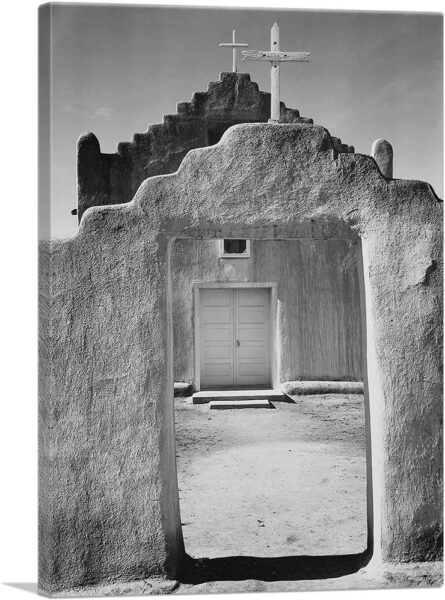Ansel Adams’ Captivating Lens: Unveiling the Church at Taos Pueblo: Ansel Adams, renowned for his breathtaking black-and-white landscape photography, left an indelible mark on the world of visual arts. Among his many iconic works, the photograph of the Church at Taos Pueblo, New Mexico, stands out as a masterpiece that captures the spirit of the American Southwest. In this blog article, we delve into the story behind this captivating image and explore the unique qualities that make it a timeless piece of art.
The Church at Taos Pueblo: Situated against the rugged backdrop of the Sangre de Cristo Mountains, the Church at Taos Pueblo is a centuries-old adobe structure that holds both historical and cultural significance. The pueblo itself is one of the oldest continuously inhabited communities in the United States, with roots tracing back over a millennium. The church, built in the early 19th century, is a testament to the enduring connection between the indigenous people of Taos and their rich cultural heritage.
Adams’ Artistic Vision: Ansel Adams was known for his meticulous approach to photography, often spending significant time composing and waiting for the perfect lighting conditions. In the case of the Church at Taos Pueblo, Adams’ artistic vision shines through in the way he masterfully captures the interplay of light and shadow on the adobe walls. The photograph showcases the stark contrast between the sunlit portions of the church and the shadows that accentuate its texture. Adams’ keen eye for detail brings out the intricate patterns of the adobe bricks, creating a visual feast for the viewer. The play of light not only highlights the architectural features of the church but also adds a spiritual dimension to the image, as if the building itself is a vessel of history and culture.
Composition and Symmetry: Adams’ mastery of composition is evident in the way he frames the Church at Taos Pueblo. The photograph is a testament to his commitment to capturing not just a scene but an entire experience. The church is positioned centrally, drawing the viewer’s attention, while the surrounding landscape provides context and depth. The symmetrical balance in the composition adds a sense of harmony and timelessness to the image. Adams’ deliberate framing allows the viewer to appreciate the church as a focal point within the vastness of the New Mexican landscape. The result is a photograph that transcends mere documentation, inviting contemplation and reflection on the intersection of nature, culture, and spirituality.
Legacy and Impact: Ansel Adams’ photograph of the Church at Taos Pueblo is not just a snapshot frozen in time; it is a visual narrative that continues to resonate with audiences worldwide. The image has become a symbol of the enduring connection between humanity and the natural world, as well as a tribute to the rich cultural tapestry of indigenous communities. In conclusion, Adams’ ability to capture the essence of a place through his lens is exemplified in the iconic photograph of the Church at Taos Pueblo. Through the interplay of light, composition, and a deep appreciation for the subject matter, Adams has left us with a timeless piece of art that invites us to explore the intersection of history, culture, and the sublime beauty of the American Southwest.

